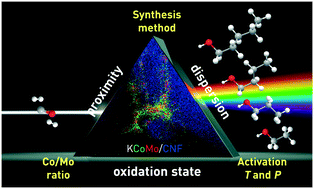当前位置:
X-MOL 学术
›
Catal. Sci. Technol.
›
论文详情
Our official English website, www.x-mol.net, welcomes your feedback! (Note: you will need to create a separate account there.)
Carbon nanofibres-supported KCoMo catalysts for syngas conversion into higher alcohols
Catalysis Science & Technology ( IF 5 ) Pub Date : 2017-11-06 00:00:00 , DOI: 10.1039/c7cy01908d Ho Ting Luk 1, 2, 3, 4, 5 , Tim Forster 1, 2, 3, 4, 5 , Cecilia Mondelli 1, 2, 3, 4, 5 , Sebastian Siol 5, 6, 7 , Daniel Curulla-Ferré 8, 9, 10 , Joseph A. Stewart 8, 9, 10 , Javier Pérez-Ramírez 1, 2, 3, 4, 5
Catalysis Science & Technology ( IF 5 ) Pub Date : 2017-11-06 00:00:00 , DOI: 10.1039/c7cy01908d Ho Ting Luk 1, 2, 3, 4, 5 , Tim Forster 1, 2, 3, 4, 5 , Cecilia Mondelli 1, 2, 3, 4, 5 , Sebastian Siol 5, 6, 7 , Daniel Curulla-Ferré 8, 9, 10 , Joseph A. Stewart 8, 9, 10 , Javier Pérez-Ramírez 1, 2, 3, 4, 5
Affiliation

|
The development of industrially-viable heterogeneous catalysts for higher alcohol (HA) synthesis via direct syngas conversion is hindered by the limited understanding of structural and electronic descriptors of their performance. Here, K-promoted CoMo(5 wt%)-based catalysts were investigated to shed light onto property–function relations. Evaluation of impregnated oxides and C-based materials identified a higher HA selectivity for the catalyst supported on carbon nanofibres obtained by the simultaneous addition of all metals. Using this carrier, additional solids were synthesised via ball milling as well as a sol–gel method with citric acid, which enhanced the CO conversion. After confirming the positive influence of K and a unitary Co/Mo ratio, the impact of temperature (573–773 K) and pressure (0.1–5 MPa) upon activation through reduction by hydrogen was investigated. A combination of two steps, one at 723 K and ambient pressure, fostering the HA selectivity (22%), and a second, more extended, at 573 K and 5 MPa, boosting the CO conversion (14%), maximised the space time yield of HA, which matches that of the best comparable CoMo system reported in the literature (ca. 0.12 gHA gcat−1 h−1) in spite of the 13-times lower metal loading. Characterisation by X-ray diffraction, temperature-programmed reduction by H2, X-ray photoelectron spectroscopy, operando infrared spectroscopy and electron microscopy uncovered that this originated from the atomic intermixing of Co and Mo in binary oxide phases and their high dispersion, enabling proximity and an effective reduction to low oxidation states of the metal sites (0 and +2 for Mo and 0 for Co) upon activation and reaction.
中文翻译:

碳纳米纤维负载的KCoMo催化剂,用于将合成气转化为高级醇
对于通过直接合成气转化来高级醇(HA)合成的工业上可行的非均相催化剂的开发由于对它们的性能的结构和电子描述符的了解有限而受到阻碍。在这里,研究了K促进的CoMo(5 wt%)基催化剂,以阐明性能与功能的关系。对浸渍的氧化物和C基材料的评估表明,通过同时添加所有金属获得的碳纳米纤维负载的催化剂具有更高的HA选择性。使用该载体,通过球磨以及柠檬酸的溶胶-凝胶法,可提高一氧化碳的转化率。在确认了K的积极影响和单一的Co / Mo比之后,研究了温度(573–773 K)和压力(0.1–5 MPa)对通过氢还原活化的影响。这两个步骤的组合,一个在723 K和环境压力下进行,可提高HA的选择性(22%),第二个则在573 K和5 MPa下进行进一步扩展,从而提高了CO的转化率(14%),从而使时空最大化HA的产率,与文献中报道的最佳可比CoMo系统的产率相匹配(约0.12 g HA g cat -1 h -1),尽管金属负载降低了13倍。通过X射线衍射,H 2的程序升温还原,X射线光电子能谱,操作红外光谱和电子显微镜的表征发现,这源自于Co和Mo在二元氧化物相中的原子混合以及它们的高分散性,从而使其接近。并在活化和反应后有效还原金属位点的低氧化态(Mo为0和+ 2,Co为0)。
更新日期:2017-11-16
中文翻译:

碳纳米纤维负载的KCoMo催化剂,用于将合成气转化为高级醇
对于通过直接合成气转化来高级醇(HA)合成的工业上可行的非均相催化剂的开发由于对它们的性能的结构和电子描述符的了解有限而受到阻碍。在这里,研究了K促进的CoMo(5 wt%)基催化剂,以阐明性能与功能的关系。对浸渍的氧化物和C基材料的评估表明,通过同时添加所有金属获得的碳纳米纤维负载的催化剂具有更高的HA选择性。使用该载体,通过球磨以及柠檬酸的溶胶-凝胶法,可提高一氧化碳的转化率。在确认了K的积极影响和单一的Co / Mo比之后,研究了温度(573–773 K)和压力(0.1–5 MPa)对通过氢还原活化的影响。这两个步骤的组合,一个在723 K和环境压力下进行,可提高HA的选择性(22%),第二个则在573 K和5 MPa下进行进一步扩展,从而提高了CO的转化率(14%),从而使时空最大化HA的产率,与文献中报道的最佳可比CoMo系统的产率相匹配(约0.12 g HA g cat -1 h -1),尽管金属负载降低了13倍。通过X射线衍射,H 2的程序升温还原,X射线光电子能谱,操作红外光谱和电子显微镜的表征发现,这源自于Co和Mo在二元氧化物相中的原子混合以及它们的高分散性,从而使其接近。并在活化和反应后有效还原金属位点的低氧化态(Mo为0和+ 2,Co为0)。


























 京公网安备 11010802027423号
京公网安备 11010802027423号